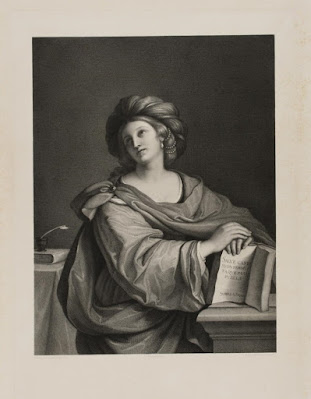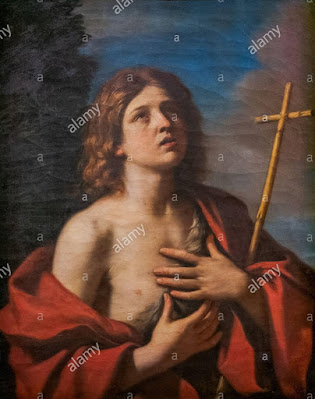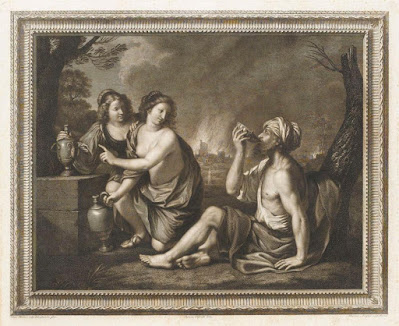 |
| Guercino (Giovanni Francesco Barbieri) Libyan Sibyl 1651 oil on canvas Royal Collection, Great Britain |
 |
| Francesco Bartolozzi after Guercino Libyan Sibyl ca. 1780 etching in black and red ink Clark Art Institute, Williamstown, Massachusetts |
 |
| Domenico Cunego after Guercino Libyan Sibyl ca. 1797 engraving Staatsgalerie, Stuttgart |
"On the 4 December 1651, a certain Ippolito Cattani (or Catanio) paid 120 ducats (equal to 150 scudi) for two half figures, a Libyan Sibyl [above] and a Samian Sibyl [the finished version, below], both of which were recorded by Malvasia for the year 1651. Soon after the ascent to the British throne of King George III (reg. 1760-1801), his Royal Librarian Richard Dalton bought the Libyan Sibyl for him, and it has remained in the Royal Collection ever since."
 |
| Guercino (Giovanni Francesco Barbieri) Samian Sibyl 1651 oil on canvas (trial version) Galleria degli Uffizi, Florence |
 |
| Guercino (Giovanni Francesco Barbieri) Samian Sibyl 1651 oil on canvas (finished version) Fondazione Cassa di Risparmio, Bologna |
 |
| Antonio Perfetti after Guercino Samian Sibyl 1833 engraving Philadelphia Museum of Art |
 |
| Guercino (Giovanni Francesco Barbieri) St John the Baptist ca. 1651 oil on canvas Pinacoteca Capitolina, Rome |
 |
| Franz von Predl after Guercino St John the Baptist 1798 etching Staatsgalerie, Stuttgart |
 |
| Pietro Ghigi after Guercino St John the Baptist ca. 1800 engraving Wellcome Collection, London |
"Both Malvasia and the account book mention several half-length and head-and-shoulder paintings of St John the Baptist from the artist's mature period, but to pin down exact commissions is virtually impossible."
 |
| Guercino (Giovanni Francesco Barbieri) Lot and his Daughters (after) 1651 oil on canvas Toledo Museum of Art, Ohio |
"[This version of Lot and his Daughters] is cited by Malvasia under the year 1651, as for Girolamo Paresi, but because of the rigid pecking order that Guercino imposed on his clients according to their social hierarchy, Panesi had to wait months for its completion. Two previous canvases of the subject, both intended at the outset for Paresi, had been commandeered by more high-ranking patrons: the first [1650], by the Commendatore Manzini, who wanted it as a diplomatic gift for the Duke of Modena, and the second [1651] by the Duke of Mantua. Both these full-length pictures were of different compositions, which explains Malvasia's emphasis on yet another fresh invention for this, Guercino's third attempt at fulfilling Panesi's commission."
 |
| Guercino (Giovanni Francesco Barbieri) Lot and his Daughters ca. 1651 drawing (compositional study) Ashmolean Museum, Oxford |
 |
| Stefano Tofanelli after Guercino Lot and his Daughters ca. 1787 engraving Staatsgalerie, Stuttgart |
 |
| workshop copyist after Guercino Lot and his Daughters (after) 1651 oil on canvas Pinacoteca Nazionale di Bologna |
 |
| Guercino (Giovanni Francesco Barbieri) Virgin and Child with Four Saints (Patrons of Modena) ca. 1651 oil on canvas Musée du Louvre |
"The patron saints of Modena – St Giminiano, St George, St John the Baptist and St Peter Martyr – are represented in the lower half of the altarpiece, carried out at the request of Francesco I d'Este, Duke of Modena. In 1649, he made known his wishes to remove Correggio's Madonna of St George from its original location in S. Pietro Martire, Modena, and hang it in the ducal picture gallery. He offered to replace Correggio's altarpiece in the church with one by Guercino, representing the same saints, commonly known since the early 19th century as the 'Patron Saints of Modena'. . . . In 1783, [Guercino's] painting was transferred to the ducal gallery, and in 1796 it was requisitioned by the French and has stayed at the Louvre ever since."
 |
| Guercino (Giovanni Francesco Barbieri) Virgin and Child with Four Saints (Patrons of Modena) ca. 1651 drawing (compositional study) National Gallery of Art, Washington DC |
– quoted texts from The Paintings of Guercino: a revised and expanded catalogue raisonné by Nicholas Turner (Rome: Ugo Bozzi Editore, 2017)